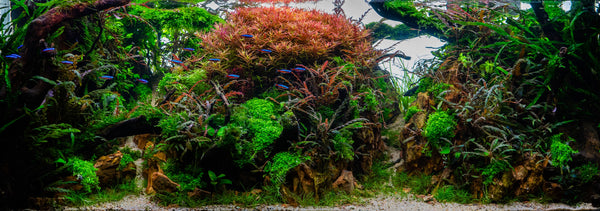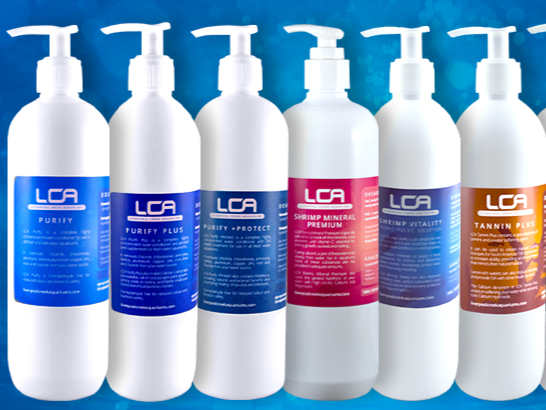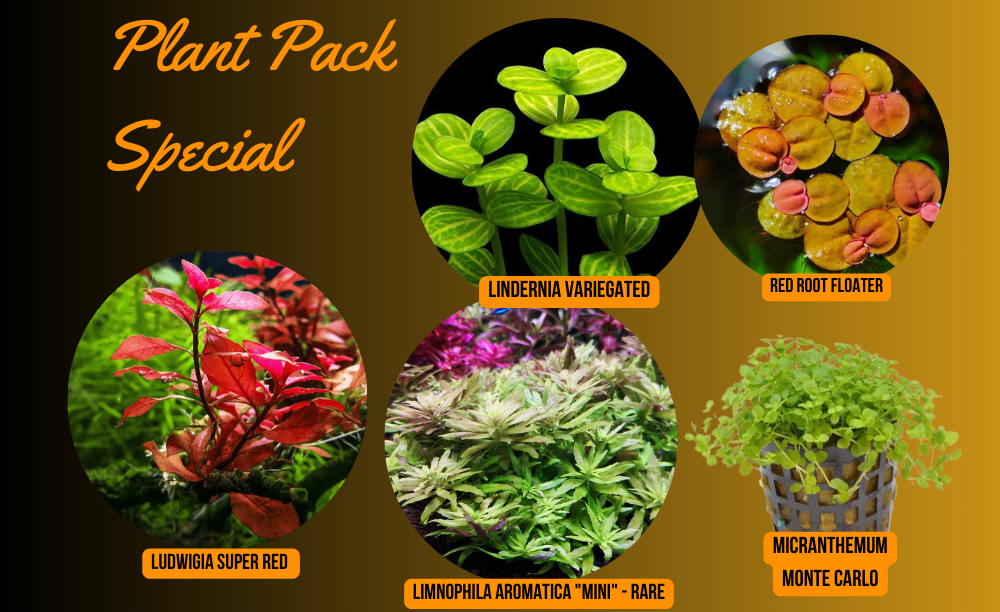Your Cart is Empty
we are now CLOSED FOR OUR ANNUAL BREAK
ANY NEW ORDERS WILL NOT BE SENT UNTIL EARLY JANUARY
***FREE SHIPPING ON ORDERS OVER $200***
we are now CLOSED FOR OUR ANNUAL BREAK
ANY NEW ORDERS WILL NOT BE SENT UNTIL EARLY JANUARY
***FREE SHIPPING ON ORDERS OVER $200***
Store

Red Plants and Iron
3 min read
Red Plants and Iron
It’s commonly asserted by planted tank hobbyists that dosing increased amounts of Iron in your aquarium will improve the red colouration of your plants, or make them more vibrant. Unfortunately this is a myth, although it is not altogether incorrect.
The role of Iron in planted aquariums is complicated, but two of the main metabolic processes it contributes to is the production of chlorophyll and the ability to produce pigmentation.
If your aquarium is deficient in Iron, your plants will have a difficult time photosynthesising and producing pigments, so they will look pale and unhealthy. Adding Iron will very likely enhance the colouration of your plants as well as their health, but there are many other influences on plant colouration that also need to be considered.
You can imagine how hobbyists with Iron deficient tanks would see a big change in their plant colours after adding it and assume it was the only deciding factor!
In reality, if you are regularly dosing a quality comprehensive fertiliser your plants should not be deficient in Iron. It is a micronutrient, meaning plants use it in very small amounts compared to macronutrients like Nitrogen.
So what else do I need to do for red plants?
The strength and spectrum of your lighting is one of the most important contributing factors in the colouration of your plants.
Using a high intensity light causes plants to produce more red pigmentation as a protective measure. Weaker lighting will reduce the amount of red pigmentation and you will instead see more of the chlorophyll which is green. In plants, this may present as orange leaves instead of the expected red.
The spectrum of your lighting should be skewed more towards red and blue which can further stimulate the development of red pigmentation and make these colours appear more vibrant as well.
The other most important contributor in plant colouration is CO2. While CO2 exists naturally in all planted aquariums, it is only in very small amounts. By adding pressurised CO2 to your planted tank, your plants will photosynthesise at a much faster rate and their colouration will be drastically improved providing lighting and nutrient needs are met.
How can I tell if my plants are getting enough Iron?
Iron is an “immobile” nutrient. That means that once absorbed and fixed in place by plants, it is not moved again. It will be transported by the plant to where it is needed most – areas of new growth. So if your plants are deficient in Iron, new growth is where you will notice it rather than old leaves.
A telltale sign of Iron deficiency is loss of colour in new leaves. If they’re typically green, leaves may appear yellow instead. Leaves that are normally red may appear orange.
Normally Iron will be in sufficient quantities in planted aquariums as it’s only needed in small amounts, around 0.5-1.5 parts per million. However, if your substrate is inert or you’re not adding any liquid fertiliser to your water column and you notice new growth is pale or otherwise discoloured, it is possible you have an Iron deficiency.
It should be noted that there are other factors that can contribute to a loss of colour in new growth – for example, if you have changed to a less intense light or if a plant is still adapting it can cause a less vibrant appearance.
I’m using an LCA liquid fertiliser, do I need to add more Iron?
All LCA fertilisers contain enough Iron for even the most demanding planted aquariums provided they are dosed according to instructions.
If you are noticing your colours are not as vibrant as expected, consider adjusting lighting or CO2 first as we have discussed in this article. If colouration still does not improve, especially in new growth, you can always try adding more Iron and observe for changes.
It’s also important to note that there are some species of plants such as Rotala Rotundifolia that will only achieve red colouration with limited nitrates in the water column. If you want red colouration in these plants, apart from intense lighting and pressurised CO2, you need a nutrient rich substrate and regular lean fertilisation with products such as LCA Advanced Red or LCA NP Free.
From The LCA Team
Every Solution For Your Aquarium
The role of Iron in planted aquariums is complicated, but two of the main metabolic processes it contributes to is the production of chlorophyll and the ability to produce pigmentation.
If your aquarium is deficient in Iron, your plants will have a difficult time photosynthesising and producing pigments, so they will look pale and unhealthy. Adding Iron will very likely enhance the colouration of your plants as well as their health, but there are many other influences on plant colouration that also need to be considered.
You can imagine how hobbyists with Iron deficient tanks would see a big change in their plant colours after adding it and assume it was the only deciding factor!
In reality, if you are regularly dosing a quality comprehensive fertiliser your plants should not be deficient in Iron. It is a micronutrient, meaning plants use it in very small amounts compared to macronutrients like Nitrogen.
So what else do I need to do for red plants?
The strength and spectrum of your lighting is one of the most important contributing factors in the colouration of your plants.
Using a high intensity light causes plants to produce more red pigmentation as a protective measure. Weaker lighting will reduce the amount of red pigmentation and you will instead see more of the chlorophyll which is green. In plants, this may present as orange leaves instead of the expected red.
The spectrum of your lighting should be skewed more towards red and blue which can further stimulate the development of red pigmentation and make these colours appear more vibrant as well.
The other most important contributor in plant colouration is CO2. While CO2 exists naturally in all planted aquariums, it is only in very small amounts. By adding pressurised CO2 to your planted tank, your plants will photosynthesise at a much faster rate and their colouration will be drastically improved providing lighting and nutrient needs are met.
How can I tell if my plants are getting enough Iron?
Iron is an “immobile” nutrient. That means that once absorbed and fixed in place by plants, it is not moved again. It will be transported by the plant to where it is needed most – areas of new growth. So if your plants are deficient in Iron, new growth is where you will notice it rather than old leaves.
A telltale sign of Iron deficiency is loss of colour in new leaves. If they’re typically green, leaves may appear yellow instead. Leaves that are normally red may appear orange.
Normally Iron will be in sufficient quantities in planted aquariums as it’s only needed in small amounts, around 0.5-1.5 parts per million. However, if your substrate is inert or you’re not adding any liquid fertiliser to your water column and you notice new growth is pale or otherwise discoloured, it is possible you have an Iron deficiency.
It should be noted that there are other factors that can contribute to a loss of colour in new growth – for example, if you have changed to a less intense light or if a plant is still adapting it can cause a less vibrant appearance.
I’m using an LCA liquid fertiliser, do I need to add more Iron?
All LCA fertilisers contain enough Iron for even the most demanding planted aquariums provided they are dosed according to instructions.
If you are noticing your colours are not as vibrant as expected, consider adjusting lighting or CO2 first as we have discussed in this article. If colouration still does not improve, especially in new growth, you can always try adding more Iron and observe for changes.
It’s also important to note that there are some species of plants such as Rotala Rotundifolia that will only achieve red colouration with limited nitrates in the water column. If you want red colouration in these plants, apart from intense lighting and pressurised CO2, you need a nutrient rich substrate and regular lean fertilisation with products such as LCA Advanced Red or LCA NP Free.
From The LCA Team
Every Solution For Your Aquarium
Subscribe
Sign up to get the latest on sales, new releases and more …

Join Us
Join our Facebook group and benefit from the knowledge of
Australia’s largest community of planted aquarium enthusiasts!







